|
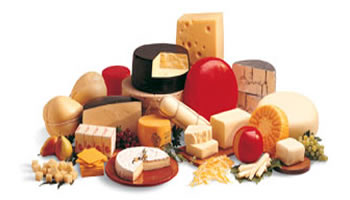 Italian Regional Cheese Italian Regional Cheese
Evidence of cheese making has been found as far back as 6,000 BC in Mesopotamia in what is now Iraq. It has always been a great way to preserve the nutritional value of milk and has always been considered a favourite food especially amongst the Europeans. Cheese has its origins in the Middle East. People were renowned for their cheese making skills. The Roman Empire adopted many of the cheese making techniques and refined the process of making cheese in many different ways.
Legend has it that an Arab traveler discovered the magic of cheese making after storing milk in a saddlebag made from an animal stomach during a desert journey. Rennin is an enzyme produced in an animal's stomach that causes milk to separate into curds and whey, allowing the curds to pressed into cheese.
As the Roman Empire spread through Europe, the secrets of making cheese spread with it. After the collapse of the empire, cheese making regions became isolated, and developed their own unique types of cheeses. The dark ages were a time of little innovation as far as cheese making was concerned it was considered unhealthy. Fortunately the isolated Monks kept the cheese making tradition alive through the middle ages.
In the early 19th century the move towards industrialization brought a renewed interest in cheese, and factories began producing it. Pasteurization (The process of pasteurization was named after Louis Pasteur who discovered that spoilage organisms could be inactivated in wine by applying heat at temperatures below its boiling point. The process was later applied to milk and remains the most important operation in the processing of milk). The process of sterilizing milk, helped popularize cheese, as it was thought of as more healthy. Until the 20th century, cheese had always been considered a specialty food. Due to the ability to mass produce it, cheese has became a staple of most diets. It has also flourished in the types available. Italy alone has almost four hundred varieties of cheese. We will provide information on the favoured major cheeses consumed and available today.
To order The Italian Cook Cheese Products online, please go to our My Shop area by clicking here.
|
| |
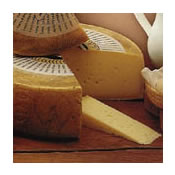 Asiago d'Allevo Asiago d'Allevo
Northwest of Venice, tucked beneath the Dolomite Mountains, artisan cheesemakers produce Asiago using traditional methods. You'll find no computer-controlled machinery or temperature-controlled rooms there, just cows and grass, men and women, and lots of Asiago. A light beige cheese peppered with small holes, Asiago d'Allevo has a slightly fruity flavor and an engaging aroma. Aged for up to five months, it is firm enough to shave or shred, and thus is often used in cooking and in salads. We however, just love to enjoy it straight!* Made from raw cow's milk, aged over 90 days.
Recipes available on The Italian Cook Recipe Website using Asiago d'Allevo Cheese: • Fried Chicken Asiago
|
|
| |
 Banon Banon
Banon is a northern Provençal cheese that comes in a 3.5-ounce mini wheel, traditionally wrapped in chestnut or grape leaves and tied with raffia. Predominantly a goat's milk cheese, Banon also has small amounts of cow's and sheep's milk blended into its recipe. It is best after having ripened for a few weeks, during which time it develops a smoother texture and richer flavor. Ripening often results in a small amount of edible blue mold under the wrapper. This mold helps to develop the flavor of the cheese. This cute little cheese has a woodsy, fruity flavor that goes well with fresh fruit and sweet dessert wines. · Made from pasteurized goat’s, ewe's and cow's milk.
|
|
| |
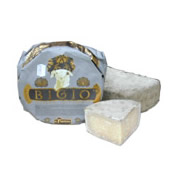 Bigio Bigio
Bigio, is a unique sheep’s milk cheese brought to us from Italy by Il Forteto. This semi-hard cheese is traditionally matured for five months and then matured under ash for an additional two to three months. This method of aging is done to speed the process, according to an old farmer’s tradition, and continues today. While ripening under the thick layer of ash, moisture is absorbed, preventing the formation of mold on the rind and acidity is removed, leaving a sweet and tasty pecorino cheese.
|
|
| |
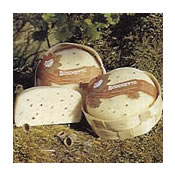 Boschetto Boschetto
Boschetto is about as amazing as a cheese gets. Its base is a sweet, tender and mild cheese made from a careful balance of cow’s and sheep’s milk. Mixed throughout are shavings of rare white truffle that transform the cheese into a powerfully addictive delicacy. The master cheesemaker at Il Forteto has struck a precious harmony between the pronounced, pungent taste of the extremely scarce (and expensive) white truffle and the blended milk cheese. The result is a scent and a flavor that simply bowls you over with delight. To separate this product from the rest of their product line, Il Forteto hand-packs each finished piece in its own wooden basket.
* Made from pasteurized ewe and cow's milk.
|
|
| |
 Bra Bra
Although Bra is named after a small town in the Italian province of Cuneo in Piedmont, this cow’s milk D.O.C. cheese was never actually made there. The farmers and herdsmen in this area, however, let it mature in their cellars and sell it everywhere. Bra is most closely linked to the nomadic herdsmen of Italy who come from the valleys of Italy to winter on the plain of Cuneo. They provide the milk for the cheese and often even make and/or age the cheese. Bra is available in soft and hard versions. The type that we carry is aged for approximately six months to develop a piquant, yellow-orange paste that is hard enough to grate and is, therefore, wonderful for use in baking, as well as being a flavorful table cheese.· Made from raw cow’s milk, aged over 60 days.
Recipes available on The Italian Cook Recipe Website using Bra Cheese: • Omelette with Truffles and Bra Cheese
|
|
| |
 Brillo di Treviso Brillo di Treviso
Brillo di Treviso combines these two Italian classics, cheese and wine, in beautiful harmony. This wine-washed cheese comes to us from Venice, where it is made from pasteurized cow’s milk and washed with red wine. Because the cheese is made in individual one-pound wheels, each bite tastes distinctly of robust, fruity Italian red wine. The vivid, burgundy-colored rind encases an ivory interior of semi-soft cheese with a slight tang that nicely compliments the wine. The attractive mini-wheel is wrapped in rustic brown paper that is imprinted with Brillo’s logo. Ideal as a table cheese, Brillo also melts beautifully.· Made from pasteurized cow’s milk.
|
|
| |
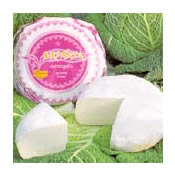 Brinata (Sheep's Milk Brie) Brinata (Sheep's Milk Brie)
Brinata means early morning frost in Italian. This cheese is the world's only sheep's milk brie. Made from a complex production process with only the purest sheep's milk, Brinata has an edible, delicate white mold rind and a soft, smooth texture. It tastes like an exquisite brie, but with a slight sheepy tang and a bit more moisture. Flown in to us bi-weekly straight from the fields of Mugello in Tuscany, you won't find a fresher imported cheese anywhere else in the U.S.A.· Made from pasteurized sheep’s Milk.
|
|
| |
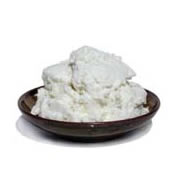 Buffalo Milk Ricotta Buffalo Milk Ricotta
We were really surprised when we first tasted this ricotta by how flavorful it is. We had hesitated in carrying a ricotta online because we love to buy cheese made that day and to eat it right away. The buffalo milk used to make this fresh cheese lends it an intensity of flavor that rivals any ricotta, no matter how fresh. Actually, ricotta is made only from the whey, the liquid part of milk that is a by-product of cheese making. When cooked, the protein particles in the whey fuse together to create the characteristic curd of ricotta, which means, “recooked.” In Italy, ricotta is often made with sheep’s milk, but in America it is usually made with cow’s milk and is fairly neutral. Our product is different in flavor from both of those varieties, but can be used in the same ways. It can be eaten as is, like cottage cheese, or served with fresh fruits and vegetables. It is also wonderful for cooking, in pasta dishes, or in baking for products such as ricotta cheesecake.· Made from buffalo whey.
|
|
| |
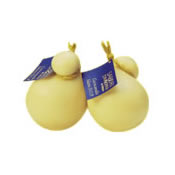 Cacio di Fossa Cacio di Fossa
Hailed as the “Millenium Cheese of Italy,” Cacio di Fossa literally means “cheese of the pit.” During the wars between Charles VIII of France and Ferdinand of Naples the inhabitants of Sogliano al Rubicone would hide their cheese in underground fossas. This tradition carries on according to a special and somewhat complicated ritual. In mid-August, before each cheese is tied in a burlap sack and placed in fossas dug in the porous ground (tufo), they are disinfected with fire and lined with hay. The fossas are flask shaped, about 3 meters deep and 2 meters wide. Each sack is marked with the owners’ name and stacked in layers on planks of wood and separated by sand. They are packed close together so no air can get in. The fossa is then hermetically sealed. Over the months they have undergone a total re-fermentation losing practically all the whey. On November 16th this revered cheese is “harvested” during the holiday of Santa Caterina. The cheese is pulled from the ground, cleaned, wrapped in it’s characteristic rustic brown paper, secured with a string and sold during the festivities by some, while others jealously cling to their formaggio. Fossa has an intense and somewhat piquant flavor that makes it excellent as a table cheese with fresh fruit and honey, or grated over pasta or risotto.
|
|
| |
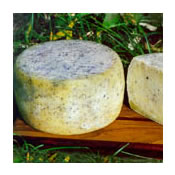 Caciotta Dei Boschi Caciotta Dei Boschi
Caciotta Dei Boschi, an elegant table cheese made from scarce Roman sheep's milk and rare black truffle shavings, is made by the highly regarded Lopez Company, a family owned and operated business that has been making cheese in the Roman countryside for several generations. Caciotta is a name used all over Central Italy that denotes a farmhouse sheep's milk cheese. This Caciotta is quite tangy and sharp, as are all sheep's milk cheeses, and highly aromatic with a distinctive, lingering aftertaste, thanks to the truffles. Caciotta Dei Boschi also contains bits of Porcini mushrooms, which serve to further augment the earthy character of this Italian masterpiece.* Made from pasteurized ewe's milk.
|
|
| |
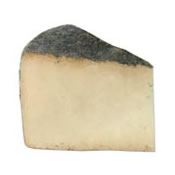 Conciato al Pepe Nero Conciato al Pepe Nero
Made from sheep’s milk and aged for 6 months, this pecorino is certainly firm enough to grate but is also great as a table cheese. Concerto al Pepe Nero translates to “dressed in black pepper” and is the perfect description for this fine selection from Venice. This cheese is entirely coated with coarse black pepper that offers a distinct bite with a little heat.
|
|
| |
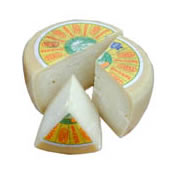 Crema di Roma Crema di Roma
Lopez is widely considered to be one of the finest producers of Pecorino Romano. This Roman cheese producer also makes several other cheeses. Among them is this cow’s milk table cheese, Crema di Roma. The cheese has a surprising depth of flavor for a cow’s milk cheese. In fact, upon first bite it might conjure up images of the sheep’s milk Romano for which Lopez is so well known. The cheese is intended to be table cheese, meaning it should be eaten out of hand. It is, however, slightly crumbly and certainly firm enough to grate.
|
|
| |
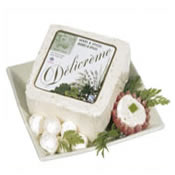 Curd Curd
1. When it coagulates, milk separates into a semisolid portion (curd) and a watery liquid (WHEY). CHEESE is made from the curd. 2. A creamy mixture made from juice (usually lemon, lime or orange), sugar, butter and egg yolks. The ingredients are cooked cool, the lemon (or lime or orange) curd becomes thick enough to spread and is used as a topping for breads and other baked goods. Various flavors of curd are available commercially in gourmet markets and some supermarkets.
|
|
| |
 Fontal Fontal
Made from pasteurized cows milk, this semi-soft table cheese pays homage to the classic Italian mountain cheese - Fontina Val d'Aosta. Like true Fontina, Fontal offers a nutty flavor and leaves behind a sweet aftertaste. It is a fabulous cheese for melting and a gourmet alternative to Mozzarella when making your own pizza!
|
|
| |
 Fontina Val d'Aosta Fontina Val d'Aosta
Fontina is the symbol of agriculture in Italy's tiny, French speaking Aosta Valley region. The cows that produce the milk for Fontina Val d'Aosta graze on high-altitude Alpine pastures dotted with wildflowers and native herbs. Fontina is a great cooking cheese, as it melts evenly without losing any flavor. But, it is best noted for its value as a savory and fruity table cheese.
|
|
| |
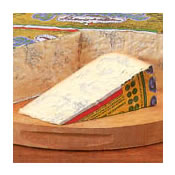 Gorgonzola Dolce Gorgonzola Dolce
From Italy's Lombardy region comes the most imitated blue cheese in the world. Many cheeses falsely claim to be gorgonzola, but they always leave you singing the blues. Authentic Italian Gorgonzola comes in two varieties; Dolce - meaning sweet, and Mountain - the sharper and firmer version. Almost spreadable, Gorgonzola Dolce is supple and luxurious with an unmistakable tangy creaminess. Its pale white interior is laced with streaks of blue, giving Gorgonzola Dolce a striking appearance to match its piquant flavor. Enjoy Gorgonzola Dolce as a table cheese, spread thickly on a piece of crusty baguette, or as an ingredient in your favorite salad dressing.* Made from pasteurized cow's milk.
Recipes available on The Italian Cook Recipe Website using Gorgonzola Cheese: • Grape & Gorgonzola Cheese Salad • Snails alla Gorgonzola • Asparagus with Gorgonzola Cheese • Scampi with gorgonzola
|
Grana Padano Stravecchio Oro del Tempo
|
| |
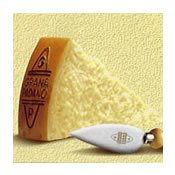 Grana Padano Grana Padano
Stravecchio Oro del Tempo is a superior, aged Grana Padano produced by Agriform near Venice. This cheese earns Grana Padano that extra prestige that it typically lacks when compared to the older Parmigiano Reggiano because it is aged for a full 22 months. This aging makes the flavor of Stravecchio more intense and complex. Like all precious things, every Stravecchio cheese is one of a kind. Its excellent quality is ascertained when it reaches the aging department and every week thereafter until the twentieth month. At those points, with skill and experience, experts select the cheeses that deserve to become prime Grana Padano, which is honored with the certificate of origin and guarantee. Stravecchio Oro del Tempo is distinguished by the unmistakable seal and label with the serial number of the diary, the place of origin, the month of production and the number of the product. · Made from raw cow’s milk.
Recipes available on The Italian Cook Recipe Website using Grana Padano Cheese: • Artichoke Salad with Grand Padano Cheese • Italian Traditional Cheese Salad
|
|
| |
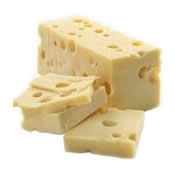 Gruviera Gruviera
Gruviera cheese; Groviera [groo-vee-YEHR-uh] This Italian version of the Swiss GRUYERE has a sweet, nutlike flavor that is very like the original. It can be used in any manner suitable for Gruyere.
|
|
| |
 Mascarpone Casa Leonardi Mascarpone Casa Leonardi
This Italian cream cheese is a native of the Lombardy region of Italy, which is also home to the fashion center of Milan and the town of Gorgonzola, or blue cheese city, as we like to call it. The best-known use of this ultra-rich dairy product is in tiramisu, which means “pick me up” and is a delicate dessert made with mascarpone, liqueur and ladyfingers. It is also delicious straight, topped with fresh berries, or in a savory spread when mixed with anchovies, mustard, and herbs. The distinction 'cream cheese' is only half correct regarding mascarpone. It is made from the cream of cow’s milk, but no cheese starter or rennet is used in its production. Rather than being churned like butter, mascarpone is made by draining the moisture from heavy cream using a small amount of citric acid and finely woven cloth. The result is an extremely smooth, slightly sweet fresh “cheese” that is similar to Devon Cream or Clotted Cream.
|
|
| |
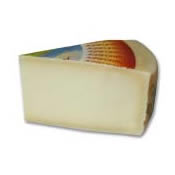 Montasio Oro del Tempo Montasio Oro del Tempo
Montasio is a pasture-terraced mountain located to the northeast of Venice in the Friuli-Venezia region of Italy. The cheese Montasio was originally made by the monks who occupied the monastery that owned those pastures in the thirteenth century. Today, the cheese is a DOC cheese, which means its properties and production are protected by law. Montasio can now be made legally in all of Friuli- Venezia Giulia and parts of Veneto. Made in large wheels and aged for one year, the flavor of this cheese is sharp, nutty, and slightly fruity. Since the mountain milk from which Montasio is made is high in butterfat, the cheese has a richer flavor with hints of butterscotch. * Made from unpasteurized cow’s milk, aged for twelve months
|
|
| |
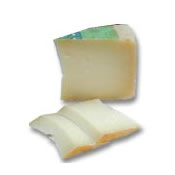 Monte Veronese Monte Veronese
Skilled artisans hand craft Monte Veronese Latte Interno in Lessinia, the picturesque mountain area above Verona. Lessinia uniquely represents almost all the climactic zones existing in Italy. Monte Veronese is a typical Italian table cheese produced only with full-cream cow’s milk. It is a semi-hard, semi-cooked, white or slightly straw-coloured cheese with a scattering of tiny, diffused holes. Monte Veronese is aged approximately 30 days to create a sweet yet delicate and pleasant flavor. * Made from pasteurized cow's milk.
|
|
| |
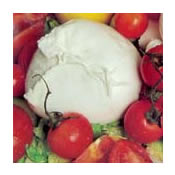 Mozzarella di Bufala Mozzarella di Bufala
The history of Mozzarella is linked to that of the water buffalo. Nobody really knows exactly when the first water buffaloes came to Italy, but one account claims that it was in the year 596 AD when they were brought across the Mediterranean. This oft-copied but never duplicated gem is a fresh, drawn-curd cheese made from whole buffalo's milk. It is porcelain-white in color, spherical in shape with a very thin glossy rind. Mozzarella di Bufala has a springy texture and a pleasantly sourish taste with a faint mossy smell, reminiscent of the humid grazing fields of Southern Italy. Each ball comes vacuum-packed in its own brine filled pouch. If you've never had the real Mozzarella before, it's definitely time you tasted this sublime delicacy. * Made from pasteurized buffalo's milk.
Recipes available on The Italian Cook Recipe Website using Mozzarella di Bufala Cheese: • Traditional All Dressed Pizza
|
|
| |
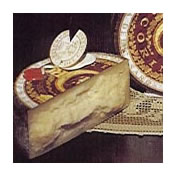 Oro Antico Riserva Oro Antico Riserva
Oro Antico Riserva
Each Oro Antico Riserva is handmade by the master cheese-maker at Il Forteto by taking a select, young, delicious, authentic Pecorino Toscano, burnishing it with olive oil and aging it in a stone cellar for six months. During aging, more olive oil is applied to the rind as the cheese gets harder and tangier. Finally, each cheese is given a seal of red wax to indicate its special heritage. Oro Antico Riserva has a grainy texture due to the aging process whereby most traces of moisture escape from within the cheese. Made from 100% ewe's milk, the flavor is delivered to the back of your tongue with delicate force, imparting overtures of wild herbs and lemon grass. Because sheep's milk contains a very high percentage of butterfat, Pecorinos are very flavorful but have a tendency to "cry" when they reach room temperature. * Made from pasteurized ewe's milk.
|
|
| |
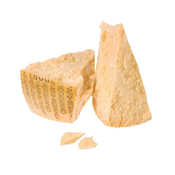 Parmigiano Reggiano Parmigiano Reggiano
The Italians are horrified by our usage of this, the world's most famous hard cheese. Thought of here in the States as purely a grating cheese, the rest of the world savours Parmigiano-Reggiano as a delicious, full-flavored eating cheese. It began life seven centuries ago in the Italian provinces of Parma, Reggio Emilia, Modena, part of Bologna and part of Mantua. Nature blessed this zone with the most idealistic cattle grazing land to create the unique milk from the "Zone Tripica". The local cheese craftsmen took it from there, utilizing a totally natural process that has not changed for 700 years. No additives, no machinery, no gimmicks... just sweet, fresh milk in its pristine state... then the artisan's ancient skills... and then nature's own good time (aged from 18 to 36 months). What you see today is just what the knights, serfs, saints and kings of old got! And please, don't compare it to the pre-grated "Parmesan" cheese found in the green can in aisle 4 of the grocery store. * Made from raw cow's milk, aged over 18 months.
Recipes available on The Italian Cook Recipe Website using Parmigiano Reggiano Cheese: • Turkey Filets with Parmigiano Reggiano • Chicken in Pasta with Sun Dried Tomatoes • Baked Asparagus • Caesar Salad • Basic Garlic Bread • Panzanella • Risotto Milanese
|
|
| |
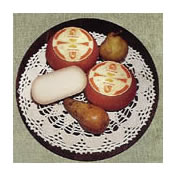 Pecorino Antico Mugello Pecorino Antico Mugello
Also from Il Forteto, Pecorino Antico Mugello is a sheep's milk cheese aged for over six months. The crust is red from having been treated with a tomato concentrate, lending a hint of berry sweetness to the cheese. Beneath the edible rind lies a straw-colored interior full of natural energy. Special enzymes in the milk and its long aging process contribute to Antico Mugello's crackling, powerful flavor and delicate perfume. Exclusive to iGourmet in America in limited quantities. * Made from pasteurized ewe's milk.
|
|
| |
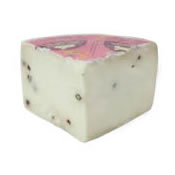 Pepato Pepato
Originating in Sicily, this aged, hard pecorino is combined with whole black peppercorns and matured to perfection. With it’s characteristic spicy taste, Pepato makes one of the tastiest table cheeses and is perfect for grating. Grate some over soups, salads, and pastas – it is an exciting alternative to the more common pecorino!
|
|
| |
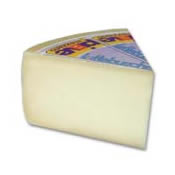 Piave Piave
Piave cheese is named after the river Piave, whose source is found at Mount Peralba in Val Visdende, in the northernmost part of the province of Belluno, Italy. A winding course brings the river toward the bottom of the valley, until it reaches the plain at the foot of the “prealpi venete’ mountains in the province of Treviso. Piave cheese is born from the cheese making traditions of the land surrounding the ancient river, in which the curd is cooked and the cheese is aged until it is hard. The area surrounding the river is also where the milk is collected to produce Piave. The cheese has an intense, full-bodied flavor that increases with age and makes this cheese absolutely unique. The Piave cheese we sell is a Mezzana cheese, which means it is aged between 60 and 120 days.
|
|
| |
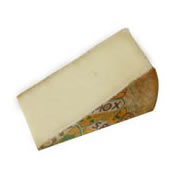 Pope Piox X Pope Piox X
Pope Piox X was born in Riese, Province of Treviso, in Venice. Out of respect for this venerable saint, they named their cheese plant and favorite cheese after him in his hometown. This popular cheese is from the same family of Venetian cheeses such as Asiago and Monte Veronese, but is closest to it’s cousin Montasio. Made of pasteurized cow’s milk, it has a firm but springy body with small holes and a slightly granular texture. The taste is sharp, with a hint of fruit and a subdued earthy quality. We prefer to serve it as a table cheese with ripe pears, but it can also be used in pastas, salads, gratins, and vegetable dishes.
|
|
| |
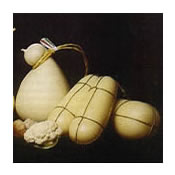 Provolone Piccante Provolone Piccante
Provolone is a Southern Italian cheese that can be thought of as Mozzarella’s older brother. Take some Mozzarella, form it into your favorite shape and rub it down with brine, bind it with rope and hang it from the ceiling for a few months and Voila! - you have just made Provolone. There are two varieties of Provolone. Dolce (meaning sweet) is the mild version and Piccante (meaning sharp) is its spicy, more aged counterpart. We sell the Piccante version, which is less available and more interesting than the mild Provolone most Americans have come to know. One of the great sandwich cheeses, Provolone Piccante is also an excellent melting cheese that is great in omelettes or on top of a toasted baguette. * Made from raw cow's milk, aged over 9 months.
|
|
| |
 Raschera Raschera
Named after Lake Raschera, which can be found at the foot of Mount Mongioie in the Italian Province of Cuneo, Raschera is an official DOC (Denominazione Di Origine) cheese of Italy. Similar to Toma, if not for is squarish shape, this soft, Piedmontese cow's milk cheese has a reddish (occasionally with a yellowish hue) rind. The ivory colored cheese has a smattering of small holes, often with a blueish tinge. The cheese is typically aged for 45 to 60 days and has a delicate, nutty taste. * Made from raw cow's milk, aged over 60 days.
|
ReNero Pecorino Stagionato
|
| |
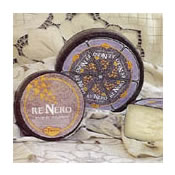 ReNero Pecorino Stagionato ReNero Pecorino Stagionato
We discovered the agricultural cooperative Il Forteto during one of our trips to Italy. In the farming town of Mugello near Florence and Tuscany, Il Forteto makes some of Italy's finest specialty cheeses. "Pecorino" signifies sheep's milk and "Stagionato" indicates that ReNero is aged for three months. Its black protective coating harkens back to the old days, when artisan cheesemakers covered their cheeses with ash to prevent mold. ReNero is very flavorful, as are most sheep's milk cheeses, and can best be described as savory and complete. ReNero is an iGourmet exclusive, and after you taste it you'll be begging us for more. * Made from pasteurized ewe's milk.
|
|
| |
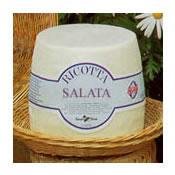 Ricotta Salata Ricotta Salata
A variation of Ricotta, this pure white, firm, rindless cheese originated in the hot, dry island climate of Sicily. It is made from lightly salted sheep’s milk curd that is pressed and dried, then aged for a minimum of three months. Ricotta Salata has a supple, mild taste. It’s not at all “sheepy” or salty, but rather has a nutty, sweet milky flavor. Extremely versatile, Ricotta Salata can be used in salads, pasta dishes and is ideal for grating. * Made from pasteurized ewe's milk.
|
|
| |
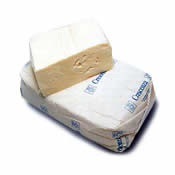 Stracchino Stracchino
STRACCHINO: [straht-CHEE-noh] A fresh, cow's-milk cheese from Italy's Lombardy region. Stracchino contains about 50 percent milk fat. Its flavor is mild and delicate - similar to but slightly more acidic than CREAM CHEESE. Stracchino Crescenza has a somewhat higher milk fat content, which results in a slightly creamier texture.
|
|
| |
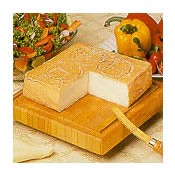 Taleggio Taleggio
The softest, creamiest member of the famous Italian Stracchino cheeses, Taleggio was first made in the valley of the same name, located in the historic province of Bergamo. Taleggio made its debut in the international cheese markets after World War I, around the same time as its cousin Bel Paese. Its rough, rosy crust (inedible), pale yellow interior, and rich and buttery, fruity, slightly salty flavor are what give Taleggio its individuality. Taleggio's soft, incredibly flavorful interior is creamy in texture and has a pungent aroma. The cheese imparts the essence of the Italian countryside in such a demonstrative manner that you could swear you were sitting among the cows on a grassy hillside in Lombardy. * Made from pasteurized cow's milk.
|
|
| |
 Toma Piedmontese Toma Piedmontese
Toma Piedmontese dates back to Roman times, but did not become identified by its name until the 11th century. The name appears to have come from the old French word “tumer,” meaning to fall or to turn. To us, Toma means the cheese is a product of several herds from the same region and implies it is made by a cheese making specialist rather than a farmer with a surplus of milk who might not be adept at cheese making. Like the Tommes of Savoie, each Alpine Valley produces its own distinctive version of Toma. Made in the Aosta Valley and Piedmont, they strain the unpasteurized milk and then rennet is added. The curds are broken up and drained, then placed in molds. They are often dried for a couple of days under a layer of mountain grasses to give them additional flavor. Toma is cheese surface ripened, meaning it ripens from the rind inward. This simple mountain cheese has a thin rind with a custard-like interior with small pores and a gentle sweet-sour nature. Toma is a perfect table cheese but can also be used for cooking. It begs to be paired with a big Piedmont red.
|
|
| |
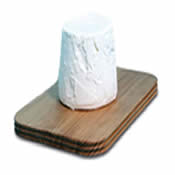 Whey Whey
whey [HWAY; WAY] The watery liquid that separates from the solids (CURDS) in cheesemaking. Whey is sometimes further processed into whey cheese (see CHEESE). It can be separated another step, with butter being made from the fattier share. Whey is also used in processed foods such as crackers. Primarily, however, whey is more often used as livestock feed than it is in the human diet.
|
Home | Advertising Information | Contact Us
Copyright ©2002 Italian Recipes Trinakria Development. All rights
reserved. |
 |
|
